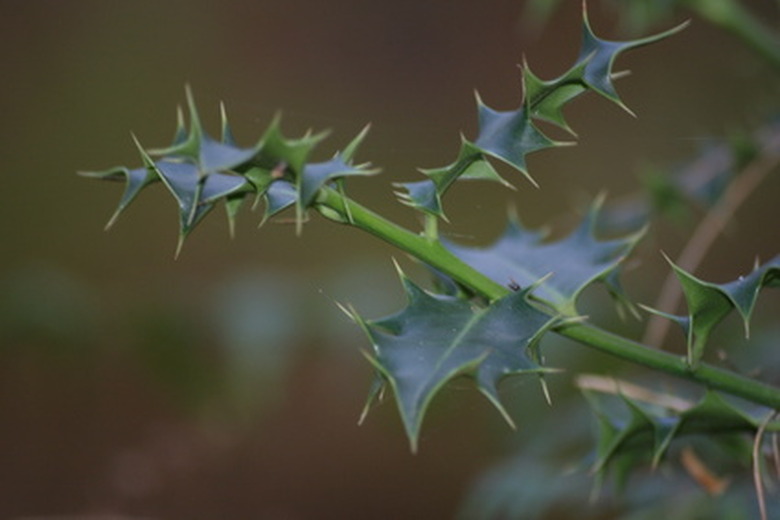Treatment For Holly Bush Leaves Turning Black
Although the holly bush is generally hardy and resistant to many diseases and insects that attack other shrubs, even with the best of cultural practices, insects can attack the holly bush. If you are in doubt as to what is infesting or infecting your holly, take a sample to your county cooperative extension agent for diagnosis. When leaves turn black, it is usually a sign of black sooty mold, which grows on insect excrement. Sooty mold, if allowed to build up on the foliage, can kill the plant by interfering with photosynthesis. It is also a clear indication of an insect problem, most commonly aphids.
Step 1
Prevent sooty mold by releasing ladybugs on the plant. Ladybugs or lady beetles eat many of the insects that infest the holly.
- Although the holly bush is generally hardy and resistant to many diseases and insects that attack other shrubs, even with the best of cultural practices, insects can attack the holly bush.
- Sooty mold, if allowed to build up on the foliage, can kill the plant by interfering with photosynthesis.
Step 2
Use a strong blast of water from the hose to wash the aphids off the holly bush.
Step 3
Spray the holly bush with a systemic insecticide if the aphid infestation is particularly heavy. Apply the insecticide at the rate suggested on the package and treat both sides of the leaves.
Step 4
Treat the holly bush while it is dormant with dormant oil spray. This will kill any aphid eggs that may overwinter on the plant. Apply the spray at the rate suggested on the label two times over the winter and again in early spring.
Step 5
Remove sooty mold from the foliage with a mixture of 4 oz. of dish detergent in 1 gallon of water. Pour the solution in a tank sprayer and drench the foliage with it. Allow the solution to remain on the foliage for three minutes and then wash the foliage with water from the hose.
- Use a strong blast of water from the hose to wash the aphids off the holly bush.
- Pour the solution in a tank sprayer and drench the foliage with it.
Treat Black Leaves On Holly Bushes
sturdy shrubs or trees with thick, glossy leaves and colorful berries, generally grow in U.S. Department of Agriculture plant hardiness zones 3 through 11, depending on the species. Although hollies vary in size, fruit color and invasive characteristics, they share a susceptibility to a sooty mold disease that turns the leaves black. Look on the stems and beneath the leaves for rounded, black or brown bumps no larger than 1/4 inch long. The bumps might look waxy, fuzzy or smooth. Scraping the scales off using an old toothbrush or your fingernails can help control small numbers of scale insects. Carefully read and follow label instructions. One neem oil product recommends using 1 to 2 fluid ounces of product for every 1 gallon of water. Using a handheld garden sprayer, thoroughly wet down the entire bush with the solution, paying special attention to the undersides of leaves. Repeat applications every seven to 14 days until scale populations are under control. Spray plants in the early morning or late evening to avoid killing pollinating insects and to reduce the risk of leaf burn. Spray oil only on calm days when the temperature is between 40 and 85 degrees Fahrenheit and rain isn't expected for at least 24 hours. Keep people and pets out of the treatment area until the solution thoroughly dries.
- sturdy shrubs or trees with thick, glossy leaves and colorful berries, generally grow in U.S. Department of Agriculture plant hardiness zones 3 through 11, depending on the species.
- Using a handheld garden sprayer, thoroughly wet down the entire bush with the solution, paying special attention to the undersides of leaves.
Things Needed
- Lady bugs
- Systemic insecticide
- Liquid dish detergent
- Tank sprayer
References
- "Taylor's 50 Best Shrubs: Easy Plants for More Beautiful Gardens"; Frances Tenenbaum; 1999
- University of California Statewide Integrated Pest Management Program: Holly — Ilex Spp.
- University of California Statewide Integrated Pest Management Program: Scale
- University of California Statewide Integrated Pest Management Program: Sooty Mold
- University of Missouri Extension: Aphids, Scales and Mites on Home Garden and Landscape Plants
- University of Florida IFAS Extension: Black, Sooty Mold on Landscape Plants
- Mississippi State University Extension Service: The Plant Doctor: Sooty Mold
- Fine Gardening: Genus — Holly
- AgriLife Extension; Texas A&M System: Using Oils as Pesticides
- Fine Gardening: Evergreen Hollies
